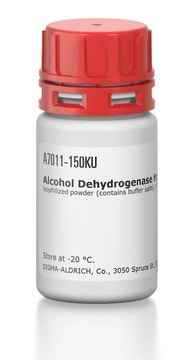10109339001
Roche
Sorbitol Dehydrogenase (SDH)
from sheep liver
Sinónimos:
SDH, Sorbitol Dehydrogenase, sorbitol
About This Item
Productos recomendados
origen biológico
sheep liver
Formulario
lyophilized
actividad específica
~40 units/mg protein (At 25 °C with D-fructose as the substrate.)
mol peso
115 kDa
envase
pkg of 10 mg (60 mg lyophilizate)
fabricante / nombre comercial
Roche
concentración
0.16 mg/mL Biuret
técnicas
activity assay: suitable
color
white
pH óptimo
7.5
solubilidad
water: 60 mg/mL, clear, colorless
idoneidad
suitable for ELISA applications
Nº de acceso NCBI
Nº de acceso UniProt
aplicaciones
life science and biopharma
actividad extraña
ADH <0.00182%
GIDH <0.00152%
Glucose-DH <0.00182% (NAD as coenz.)
LDH <0.00167%
MDH <0.00198%
NADH oxidase 0.00532%
temp. de almacenamiento
2-8°C
Información sobre el gen
sheep ... SORD(101115280)
Descripción general
Sorbitol dehydrogenase (SDH) from sheep liver has a molar mass of 152kDa. The protein is a tetramer of four identical subunits. Each of these subunits has 355 amino acid residues, of which 10 are cysteine residues. Each subunit contains a zinc atom at the active site, which is associated with three protein ligands and a water molecule. The zinc atom associates with the oxygen of the sorbitol hydroxyl or of the fructose carbonyl interconverted during catalysis.
Aplicación
Acciones bioquímicas o fisiológicas
Calidad
Definición de unidad
Forma física
Nota de preparación
Stabilizers: Maltose is used as stabilizer.
Storage conditions (working solution): An aqueous solution is stable at 2 to 8 °C for several weeks.
Almacenamiento y estabilidad
Otras notas
Código de clase de almacenamiento
11 - Combustible Solids
Clase de riesgo para el agua (WGK)
WGK 1
Punto de inflamabilidad (°F)
does not flash
Punto de inflamabilidad (°C)
does not flash
Elija entre una de las versiones más recientes:
¿Ya tiene este producto?
Encuentre la documentación para los productos que ha comprado recientemente en la Biblioteca de documentos.
Los clientes también vieron
Nuestro equipo de científicos tiene experiencia en todas las áreas de investigación: Ciencias de la vida, Ciencia de los materiales, Síntesis química, Cromatografía, Analítica y muchas otras.
Póngase en contacto con el Servicio técnico









